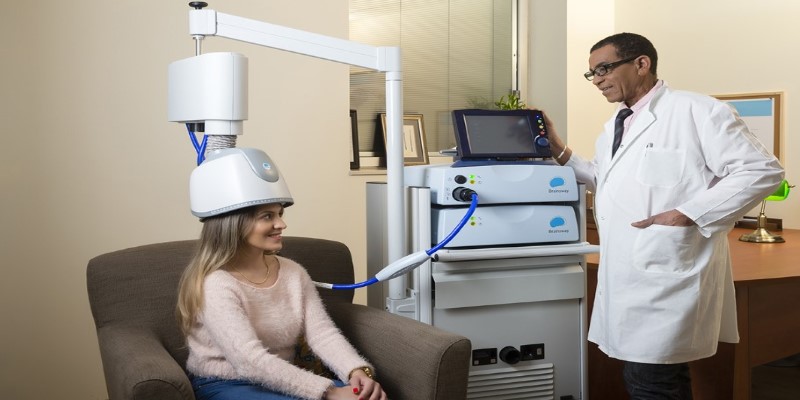Mental health challenges have become increasingly prevalent, affecting people from all walks of life. Traditional treatments like medication and talk therapy work for many, but not everyone responds well to these options. If youve tried various approaches and still find yourself struggling, theres a newer treatment that might be worth exploringTMS therapy.
Short for Transcranial Magnetic Stimulation, TMS therapy is a non-invasive procedure that targets specific areas of the brain to help improve mood and alleviate symptoms of depression, anxiety, and other mental health conditions. In this article, well break down what TMS therapy is, how it works, and whether it might be the right fit for you.
TMS therapy is a treatment method that uses magnetic pulses to stimulate nerve cells in the brain, specifically targeting areas linked to mood regulation and depression. Unlike medications, which affect the entire brain and often come with side effects, TMS focuses on the prefrontal cortexthe area associated with mood and decision-making. The process is simple: a coil is placed near the scalp, which delivers these magnetic pulses to the targeted area. This stimulation can improve communication between brain cells, potentially easing symptoms of depression and helping you feel better.
One of the biggest advantages of TMS therapy is its non-invasive nature. It doesnt require surgery, sedation, or medication. Patients remain awake throughout the session and can return to their normal activities immediately afterward. Typically, TMS therapy involves several sessions spread out over a few weeks. Each session lasts about 20 to 40 minutes, making it a manageable commitment for those with busy schedules.
The science behind TMS therapy lies in the brains electrical activity. The brain operates through a series of electrical signals that control everything from your thoughts to your movements. In people suffering from depression, certain parts of the brain, particularly the left prefrontal cortex, tend to be underactive. This underactivity contributes to the negative feelings and mood disturbances that characterize depression.

TMS therapy addresses this by delivering magnetic pulses that generate small electrical currents in the brain. These currents stimulate the underactive regions, potentially rebalancing brain activity. Over time, repeated stimulation through TMS therapy can help regulate mood more effectively, allowing you to feel better and more in control of your mental health.
Unlike electroconvulsive therapy (ECT), which is another brain stimulation treatment, TMS therapy doesnt induce seizures or require anesthesia. This makes it a more appealing option for many patients who are wary of the side effects and risks associated with other treatments.
Non-Invasive Treatment: One of the most significant benefits of TMS therapy is that its completely non-invasive. Unlike surgical procedures or treatments like deep brain stimulation (DBS), TMS doesnt require any cuts, implants, or anesthesia. You can undergo the treatment while awake and fully alert, and you can resume your regular activities immediately after each session.
Effective for Treatment-Resistant Depression: TMS therapy is particularly beneficial for individuals who have not responded well to traditional treatments like medication and talk therapy. Clinical studies have shown that TMS can reduce symptoms in people with treatment-resistant depression, offering new hope to those who have struggled with other options.
Minimal Side Effects Compared to Medication: Unlike antidepressants, which often come with side effects like weight gain, and fatigue, TMS therapys side effects are usually mild and localized. For people who are sensitive to medication or want to avoid the long-term commitment of daily pills, TMS offers a viable alternative.
Long-Lasting Results: One of the appealing aspects of TMS therapy is the durability of its effects. While most treatment plans last between four to six weeks, the benefits can extend well beyond the treatment period. Many patients experience sustained symptom relief for months, reducing the need for continuous intervention.
Mild Headache or Scalp Discomfort: The most common side effects of TMS therapy are mild headaches or discomfort at the site where the magnetic coil is placed. This sensation usually feels like light tapping or tingling. The discomfort tends to decrease as the brain adjusts to the stimulation over time. Headaches, if they occur, can often be managed with over-the-counter pain relief.
Muscle Twitching or Tingling: Some patients may experience facial muscle cramps or a tingling sensation during the procedure. These effects are generally mild and subside quickly after each session ends.

Temporary Fatigue or Lightheadedness: Though rare, some individuals report feeling slightly fatigued or lightheaded following a TMS session. This is usually temporary and doesnt last long enough to interfere with daily activities.
Risk of Seizures (Extremely Rare): The risk of a seizure during TMS therapy is extremely lowless than 0.1%. However, this risk may be slightly higher in individuals with epilepsy or those with a history of seizures. Before starting treatment, your healthcare provider will evaluate your medical history to determine if you are at increased risk.
As research continues to advance, TMS therapy is expanding beyond its initial focus on depression. Scientists are exploring its potential for other conditions like addiction, autism spectrum disorders, and even Alzheimers disease. This growing body of research indicates that TMS could play an even larger role in mental health care in the coming years.
Technological advancements are also enhancing TMS therapys precision and effectiveness. Newer devices allow for more tailored treatment based on a patients specific brain activity patterns, leading to even better outcomes. As TMS therapy becomes more widely available and insurance coverage improves, more people will have access to this innovative treatment option.
TMS therapy represents a promising solution for those who havent found relief through traditional mental health treatments. With its non-invasive nature, minimal side effects, and growing evidence of effectiveness, it offers a compelling alternative for those looking to feel better without the burden of daily medication or invasive procedures.
Whether youre dealing with depression, anxiety, or another mental health challenge, TMS therapy could be the path that finally helps you regain control of your well-being. As with any treatment, its important to consult with a healthcare provider to determine if TMS therapy is right for you.

By Sean William/Sep 02, 2024

By Isabella Moss/Sep 04, 2024

By Aldrich Acheson/Sep 03, 2024

By Verna Wesley/Sep 03, 2024

By Triston Martin/Aug 27, 2024

By Triston Martin/Aug 29, 2024

By Vicky Louisa/Aug 28, 2024

By Celia Shatzman/Aug 27, 2024

By Sid Leonard/Aug 27, 2024

By Darnell Malan/Sep 03, 2024

By Maurice Oliver/Aug 31, 2024

By Martina Wlison/Aug 31, 2024